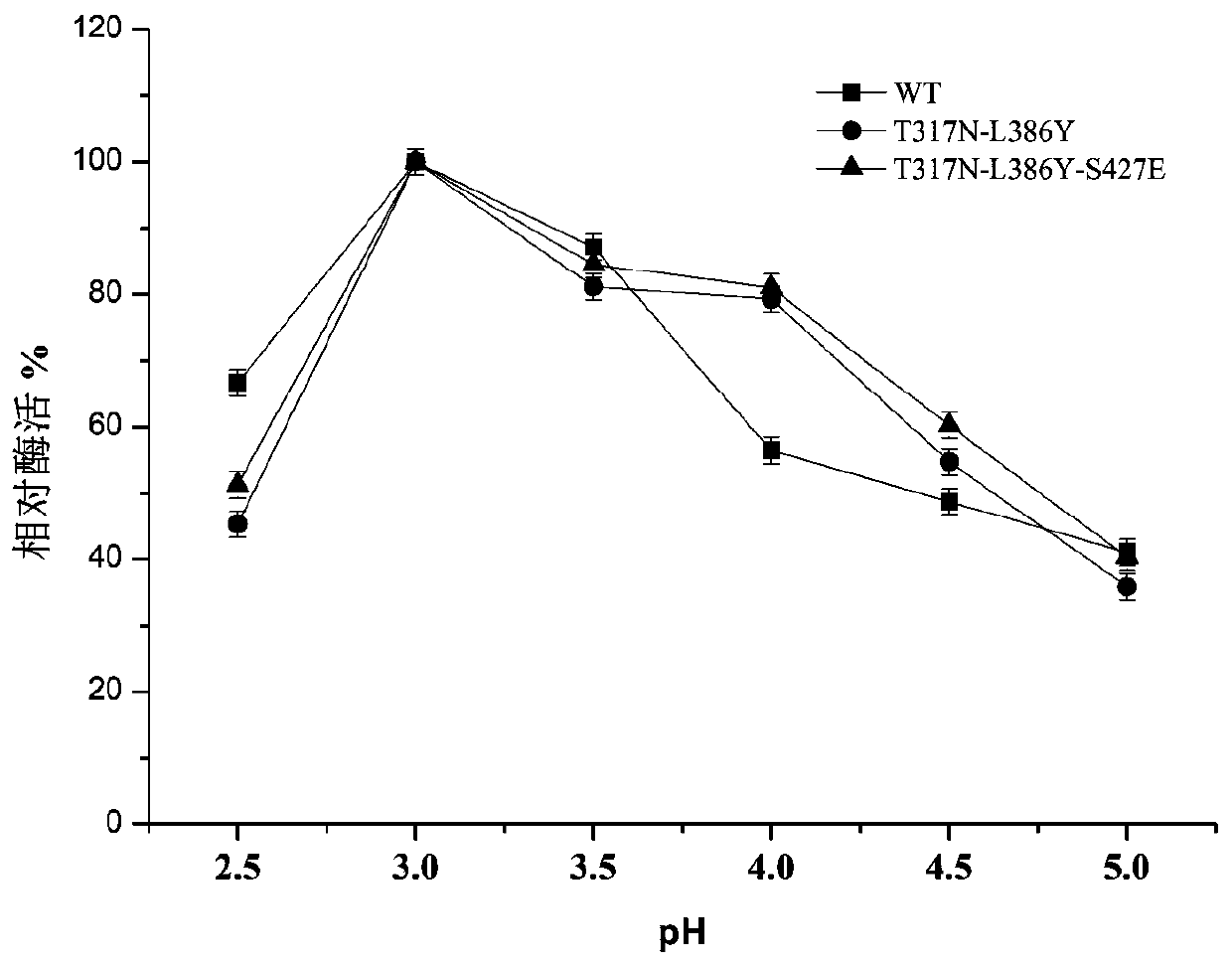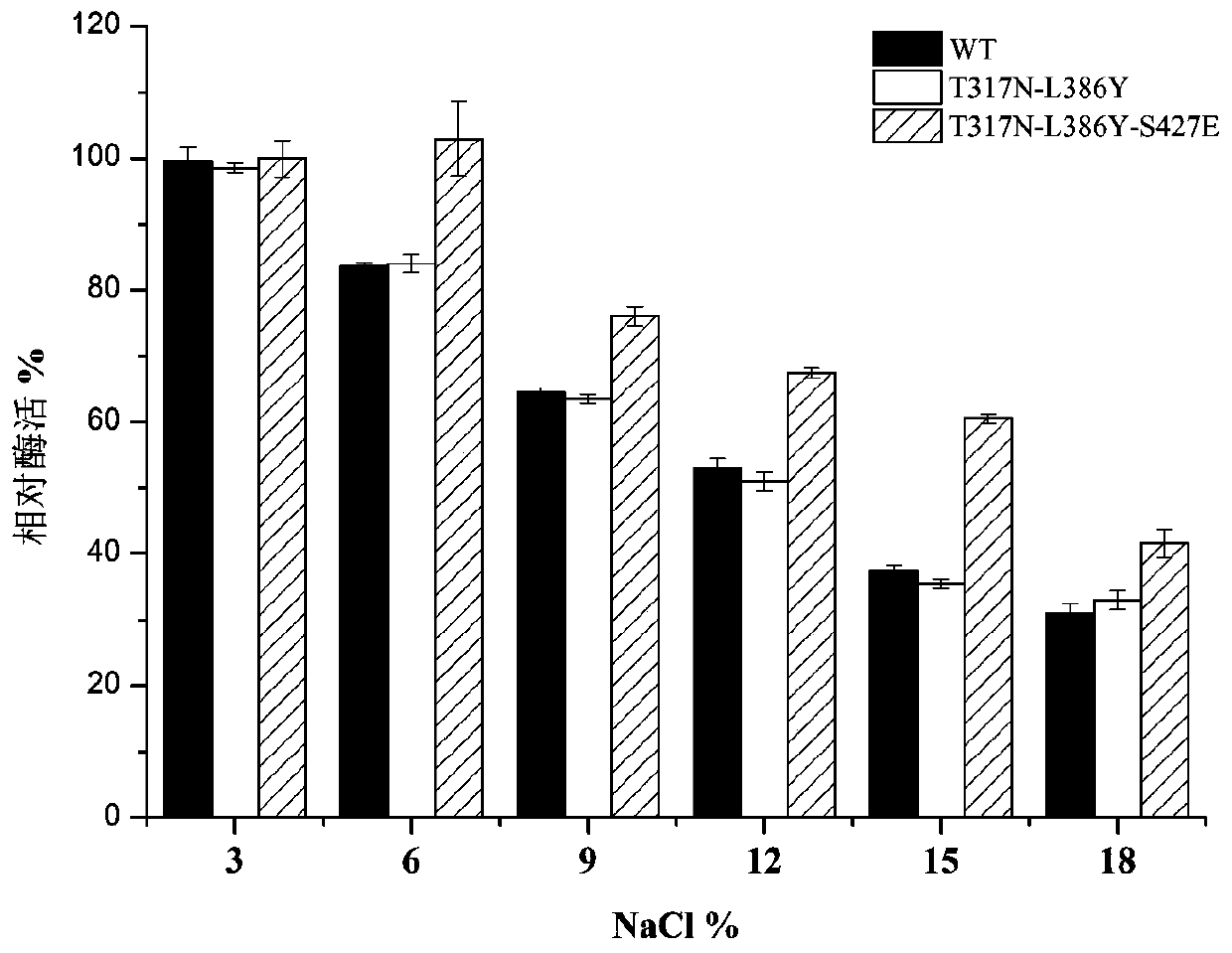Multicopper oxidase mutant with improved salt tolerance
A multi-copper oxidase and mutant technology, applied in the field of bioengineering, can solve problems such as reducing protein content, complex relationships, and changes in fermentation systems
- Summary
- Abstract
- Description
- Claims
- Application Information
AI Technical Summary
Problems solved by technology
Method used
Image
Examples
Embodiment 1
[0030] Embodiment 1: Recombinant bacteria construction
[0031] The plasmid pET28a (+) with T7 promoter is selected as the expression vector, and the mcob gene obtained by pET28a (+) plasmid and the amplified coding shown in SEQ ID NO:2 is respectively carried out Double enzyme digestion with EcoR I and Hind III, the digested product was recovered by cutting the gel, and then ligated overnight with DNA ligase Solution I, and the ligated product was transformed into Escherichia coli JM109 competent cells, cultured at 37°C for 10 hours, and positive transformation was identified by colony PCR son.
[0032] Pick 3 positive transformants, inoculate them in liquid LB medium (containing 50 μg / ml kanamycin), culture them at 37°C for 10 hours, extract the plasmids for sequencing verification, and transform the plasmid pET28a(+)-MCOB with correct sequencing results coli BL21 (DE3) competent cells, and then spread the transformant on solid LB plate medium containing 50 μg / ml kanamycin,...
Embodiment 2
[0033] Embodiment 2: Preparation of mutant T317N-L386Y
[0034] (1) Preparation of mutant T317N
[0035] According to the multi-copper oxidase gene sequence of B. amyloliquefaciens, design and synthesize the primers for introducing T317N mutation, use the rapid PCR technology, and use the expression vector pET28a(+)-MCOB as a template,
[0036] The site-directed mutagenesis primers for introducing the T317N mutation are:
[0037] Upstream primer: 5'-TTTTA AAC AACGGCACCGGCTG-3' (the underline is the mutated base)
[0038] Downstream primer: 5'-GTGCCGTT GTT TAAAATAATATGTTTCTCCG-3' (the underline is the mutated base)
[0039] The PCR reaction system is: 2x PrimerSTAR DNA polymerase 25 μL, upstream primer (10 μM) 1 μL, downstream primer (10 μM) 1 μL, template DNA 1 μL, ddH 2 O 22 μL.
[0040] The PCR amplification conditions were: pre-denaturation at 95°C for 3 minutes; followed by 30 cycles (98°C for 30 s, 55°C for 30 s, and 72°C for 7 min); and extension at 72°C for 10 min...
Embodiment 3
[0050] Example 3: Preparation of mutant T317N-L386Y-S427E
[0051] According to the gene sequence of the multi-copper oxidase of B. amyloliquefaciens, the primers for introducing the S427E mutation were designed and synthesized, and the rapid PCR technology was used to take the vector carrying the gene encoding the mutant T317N-L386Y as a template,
[0052] The site-directed mutagenesis primers for introducing the S427E mutation are:
[0053] Upstream primer: 5'-CACCTGCACTTGGTT GAG TTCCAAGTCCTTGACCGG-3' (the underline is the mutated base)
[0054] Downstream primer: 5'-CAAGGACTTGGAA CTC AACCAAGTGCAGGTGTATCGG-3' (the underline is the mutated base)
[0055] The PCR reaction system is: 2x PrimerSTAR DNA polymerase 25 μL, upstream primer (10 μM) 1 μL, downstream primer (10 μM) 1 μL, template DNA 1 μL, ddH 2 O 22 μL.
[0056] The PCR amplification conditions were: pre-denaturation at 95°C for 3 minutes; followed by 30 cycles (98°C for 30 s, 55°C for 30 s, and 72°C for 7 min)...
PUM
 Login to View More
Login to View More Abstract
Description
Claims
Application Information
 Login to View More
Login to View More - R&D Engineer
- R&D Manager
- IP Professional
- Industry Leading Data Capabilities
- Powerful AI technology
- Patent DNA Extraction
Browse by: Latest US Patents, China's latest patents, Technical Efficacy Thesaurus, Application Domain, Technology Topic, Popular Technical Reports.
© 2024 PatSnap. All rights reserved.Legal|Privacy policy|Modern Slavery Act Transparency Statement|Sitemap|About US| Contact US: help@patsnap.com










